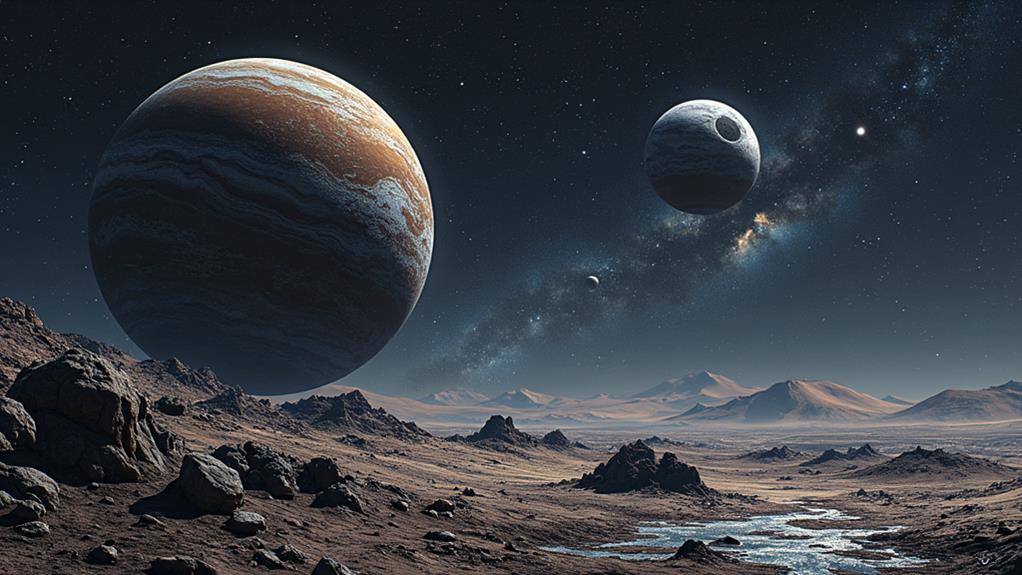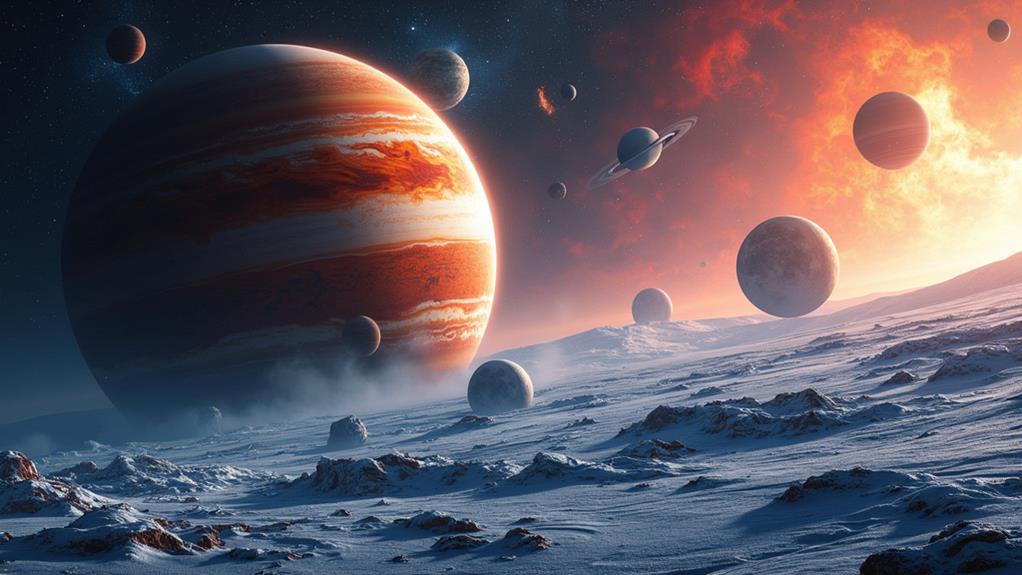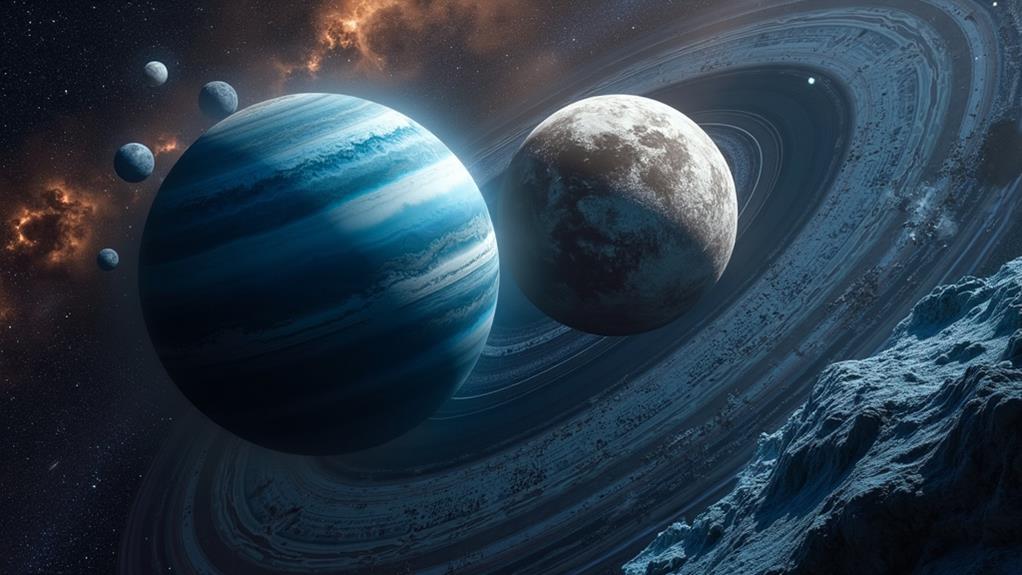NASA Missions: A Journey to Jupiter's Moons
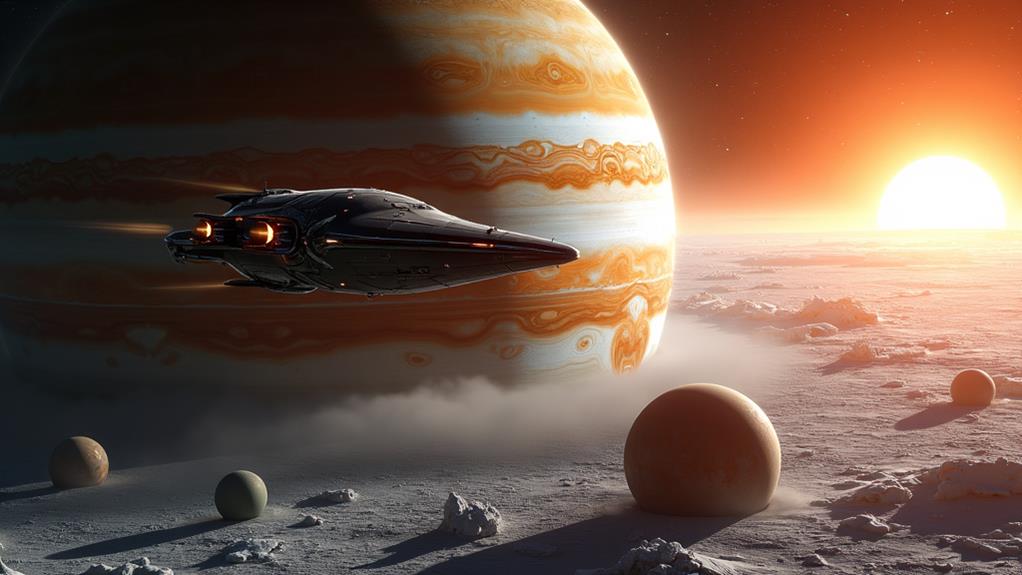
You're in for an exciting ride with NASA's missions to Jupiter's moons. Scheduled for launch in October 2024, the Europa Clipper aims to investigate Europa's subsurface ocean for signs of life. The spacecraft is designed to withstand Jupiter's harsh radiation and equipped with cutting-edge scientific instruments, like ice-penetrating radar and high-resolution cameras. Managed by JPL and engineered by Johns Hopkins, this mission builds on insights from NASA's Juno and the upcoming ESA Juice mission. Educational initiatives even let you join the adventure virtually. If you're enthusiastic to learn about the quest for extraterrestrial life, stay tuned.
Key Takeaways
- The Europa Clipper mission will launch in 2024 to study Europa's subsurface ocean for signs of habitability and potential life.
- NASA's Juno spacecraft, active since 2016, explores Jupiter's origins, atmosphere, and magnetic field.
- The European Space Agency's Juice mission, launching in 2023, aims to investigate Jupiter's icy moons, including Europa.
- The Europa Clipper is equipped with nine advanced scientific instruments to analyze Europa's ice shell, ocean, and possible biosignatures.
- Public engagement includes carrying 2.6 million names on the Europa Clipper and real-time updates via NASA's social media channels.
Europa Clipper Mission Goals
NASA's Europa Clipper mission aims to reveal the mysteries of Jupiter's moon, Europa, by focusing on its subsurface ocean, which might have twice the volume of Earth's oceans. As you engage with the mission goals, you'll find that the primary objective is to assess the habitability of this hidden ocean. Understanding Europa's potential to support life is essential, and the Europa Clipper plays a fundamental role in this investigation.
You'll see the mission examining the nature of Europa's ice shell, which covers the subsurface ocean. By analyzing the thickness and dynamics of this ice, scientists hope to unearth clues about the ocean's properties and the moon's geological activity. The Europa Clipper is also set to investigate Europa's composition and geology, providing insights into the moon's surface materials and their potential biosignatures.
The data collected will improve our understanding of Europa's astrobiological potential, offering glimpses into if this icy moon could harbor life. With advanced scientific instruments, the Europa Clipper will conduct detailed reconnaissance, paving the way for future missions to investigate other icy worlds in our solar system. This mission truly embodies the spirit of exploration and scientific inquiry.
Spacecraft Design and Features
Understanding the ambitious goals of the Europa Clipper mission naturally leads us to investigate the spacecraft's remarkable design and features that make this mission possible. The Europa Clipper stands as NASA's largest planetary mission spacecraft, reaching an impressive 16 feet in height and extending over 100 feet with its solar arrays deployed. This colossal size isn't just for show; it's fundamental for housing the sophisticated scientific instruments that will probe Europa's icy surface and subsurface.
You'll find that the Europa Clipper is built to endure Jupiter's harsh environment. Weighing in at approximately 7,145 pounds, its structure is highly radiation-tolerant. This is critical for a mission venturing so close to the gas giant. The spacecraft design includes a thick-walled avionics vault made from titanium and aluminum, ensuring its sensitive electronics remain shielded from intense radiation.
Communication is another significant aspect. A high-gain antenna onboard will facilitate long-distance communication with Earth, allowing for seamless data transmission and command operations. While the spacecraft's nine advanced scientific instruments promise groundbreaking revelations, it's the Europa Clipper's robust and creative design that truly sets the stage for this mission's success.
Scientific Instruments Overview
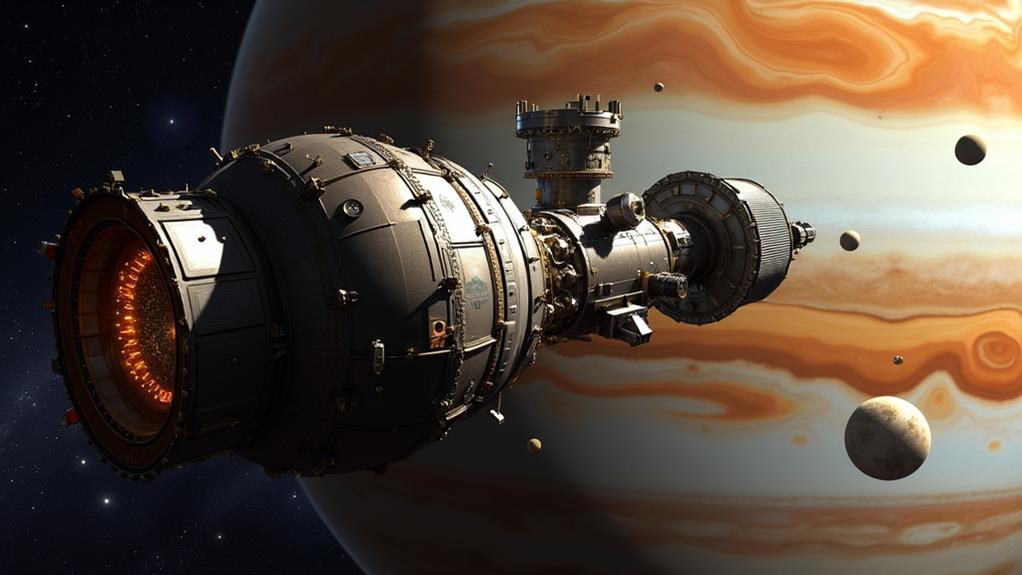
How will the Europa Clipper reveal the secrets hidden beneath Europa's icy crust? The spacecraft is equipped with cutting-edge scientific instruments designed to disclose the mysteries of this intriguing moon. One of the key tools is the ice-penetrating radar, which will allow you to study the subsurface ocean beneath Europa's thick ice layer. By sending radar waves deep into the ice, this instrument will help map the ocean's depth and structure.
Spectrometers aboard the Europa Clipper will analyze the moon's surface composition, identifying the chemical makeup of materials present. This data could reveal significant insights into the ocean's chemistry and potential habitability. The magnetometer is another essential instrument. It will measure Europa's magnetic fields, providing information about the ocean's depth and salinity—important indicators of its potential to support life.
High-resolution cameras will capture detailed images of Europa's surface, showcasing geological features and hunting for biosignatures. These images could reveal clues about the moon's history and activity. Moreover, the thermal imager will assess surface temperatures, identifying warmer areas that might indicate geological activity or hydrothermal vents. Together, these scientific instruments will offer an extensive understanding of Europa's ocean and its secrets.
Radiation Protection Measures
Protecting the Europa Clipper from Jupiter's formidable radiation environment is vital for the mission's success. To achieve this, NASA has equipped the spacecraft with a thick-walled avionics vault made from titanium and aluminum. This radiation protection strategy is essential, as it shields the sensitive electronics from Jupiter's intense radiation, which can severely degrade electronic components.
Drawing from the successful implementation in NASA's Juno mission, the Europa Clipper's vault design markedly reduces the impact of high-energy particles. This guarantees the electronics remain functional throughout the mission's duration, despite the harsh conditions they will face. The spacecraft's highly capable, radiation-tolerant design allows it to operate effectively during multiple close flybys of Europa, gathering valuable scientific data without succumbing to radiation damage.
Radiation protection measures are vital for the mission's success, enabling the Europa Clipper to fulfill its primary scientific objectives. By safeguarding the onboard instruments, the mission can collect significant data about Europa's environment, potentially revealing secrets about the moon's potential for harboring life. Fundamentally, these protective measures guarantee the mission's longevity and the integrity of its scientific endeavors.
Importance of Europa Exploration
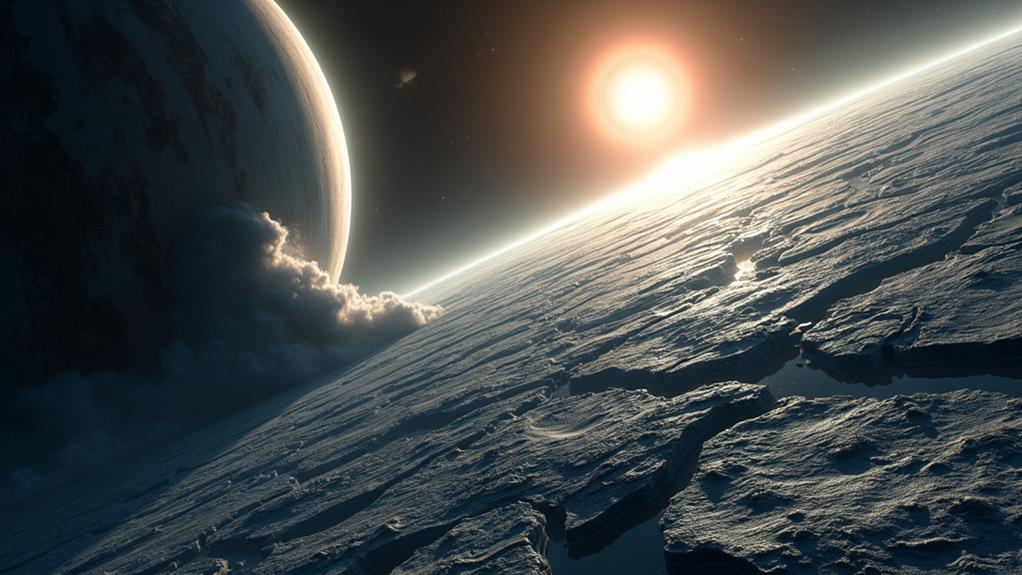
While safeguarding the Europa Clipper from Jupiter's intense radiation guarantees the mission's longevity, the exploration of Europa itself holds immense scientific value. You see, Europa is a tantalizing target for astrobiological studies because there's strong evidence suggesting it has a subsurface saltwater ocean. This hidden ocean might contain the necessary conditions for life, making it one of the best places to search for extraterrestrial life.
The Europa Clipper mission is designed to thoroughly investigate this intriguing moon. It will analyze Europa's ice shell and ocean composition, in addition to its geology, to assess its habitability and potential biosignatures. By doing so, you'll gain deeper insights into if life could exist beyond Earth.
NASA's focus on the search for extraterrestrial life makes the exploration of Europa critical. Detailed reconnaissance of Europa's environment will not only improve our understanding of icy worlds but also their potential to support life. Additionally, studying Europa will provide valuable insights into planetary habitability and the dynamics of Jupiter's moon system. This exploration will greatly expand your knowledge of ocean worlds within our solar system, offering a broader perspective on the possibilities of life in the universe.
Launch and Public Engagement
The Europa Clipper mission's launch date, set for October 10, 2024, from Kennedy Space Center aboard a SpaceX Falcon Heavy rocket, marks a significant milestone in NASA's quest to investigate Jupiter's intriguing moon. You don't want to miss this historic event, and NASA's making certain you're part of it through extensive public engagement efforts.
To improve your experience, NASA has introduced a virtual guest program. It offers curated resources, mission updates, and even a commemorative stamp for your virtual guest passport after liftoff. This program guarantees you stay connected and informed as the Europa Clipper sets out on its expedition.
In a remarkable show of inclusivity, over 2.6 million names will be carried aboard the spacecraft, symbolizing collective human interest in space exploration. This initiative underscores the mission's global significance and your role in it.
Stay updated by following NASA's social media channels, where you'll find real-time progress reports, launch preparations, and mission milestones. For media professionals, accreditation is open until September 27, 2024, for U.S. media, and until September 20, 2024, for international media. Join millions worldwide in witnessing this groundbreaking mission.
Educational and Artistic Initiatives
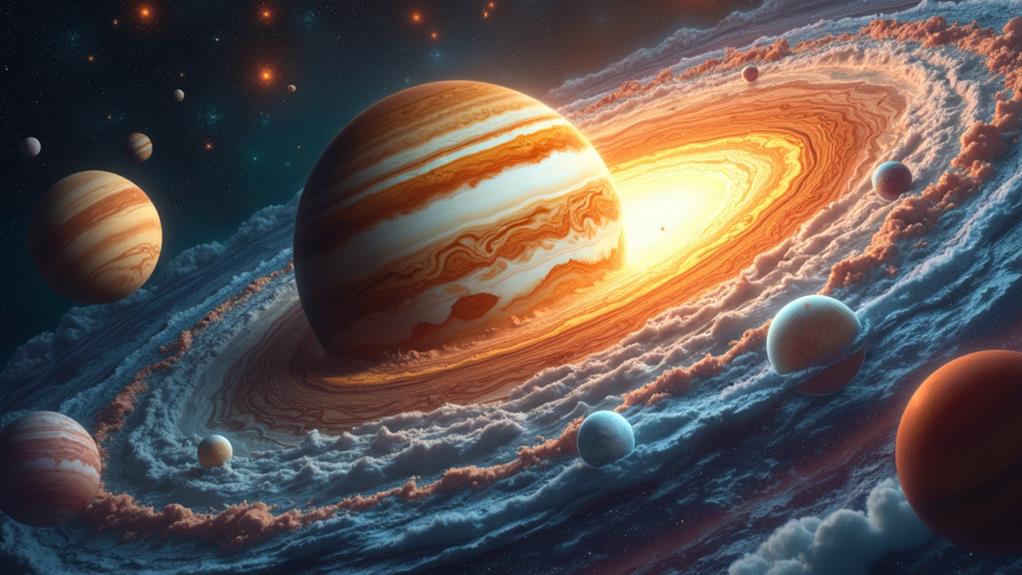
Many creative and educational opportunities are available to engage with NASA's Europa Clipper mission. If you love artistic expression, NASA Space Place is hosting an art challenge where you can investigate and depict Europa's surface. This challenge, open until September 30, 2024, aims to ignite creativity and interest in space investigation among students and the general public.
Educational resources are also provided for both students and educators. These materials are designed to improve your understanding of the Europa Clipper mission and the scientific principles behind it. Regardless of being a teacher looking for classroom activities or a student keen to learn more, these resources are invaluable.
Moreover, NASA has developed numerous programs to engage the public. You can follow mission updates and participate in mission-related activities that foster a deeper connection with the Europa Clipper mission. One exciting initiative is the virtual guest program. By participating, you'll receive a commemorative stamp for your virtual passport post-liftoff, making you feel part of this groundbreaking expedition.
These initiatives guarantee that everyone, from budding artists to enthusiastic learners, can be a part of humanity's exploration of Jupiter's moons.
Mission Management and Collaboration
Managing a mission as intricate as the Europa Clipper requires careful coordination and collaboration across several specialized teams. At the heart of mission management is Caltech's Jet Propulsion Laboratory (JPL) in California, which oversees the mission's comprehensive execution and scientific objectives. JPL's role guarantees that the mission stays on track and meets its scientific goals.
Collaboration is a key component of the Europa Clipper's success. The Johns Hopkins Applied Physics Laboratory (APL) in Maryland is responsible for the spacecraft's design and engineering. This joint effort includes contributions from JPL, APL, and NASA's Goddard Space Flight Center, assuring the spacecraft is equipped to achieve its objectives.
Program management is executed by Marshall Space Flight Center in Alabama, which coordinates diverse teams and resources to secure successful mission execution. This involves synchronizing efforts and streamlining processes to keep everything running smoothly.
The final piece of the puzzle is launch services, managed by NASA's Launch Services Program at Kennedy Space Center. They guarantee the spacecraft is launched successfully and on schedule, marking the beginning of its expedition to Jupiter's moons. This intricate web of collaboration and mission management underscores the complexity and ambition of the Europa Clipper mission.
Active Jupiter Missions
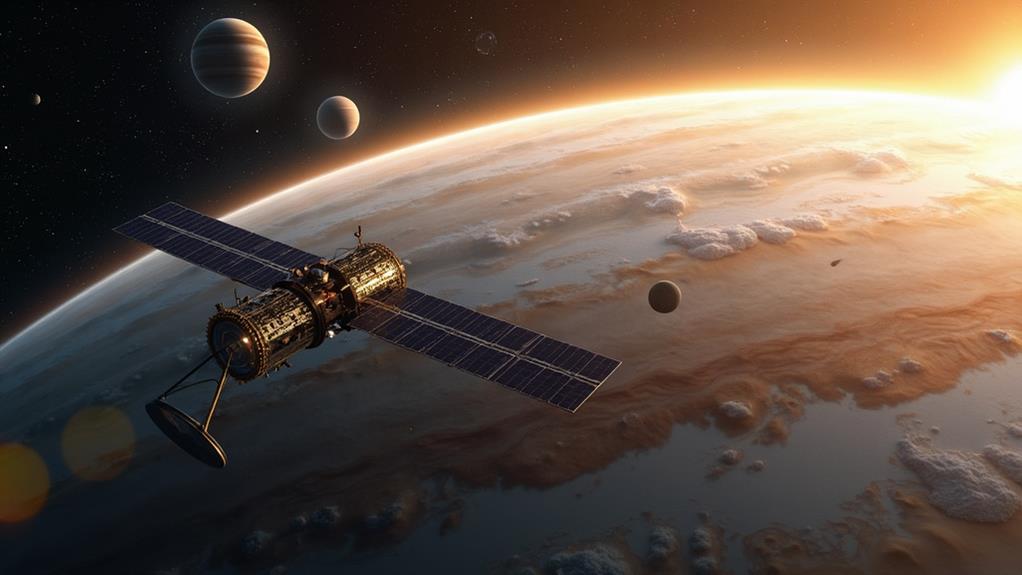
Investigating Jupiter's dynamic system is an ongoing endeavor with active missions like NASA's Juno spacecraft, which has been probing into the gas giant's origins, atmosphere, and magnetic field since 2016. Juno's detailed gravitational and magnetic measurements offer invaluable insights into Jupiter's internal structure and dynamics. You get an unprecedented look at how gas giants and their moons form and evolve, thanks to Juno's extensive data collection.
Juno's mission is complemented by the European Space Agency's Juice (Jupiter Icy Moons Explorer) mission, set for launch in 2023. Juice aims to investigate Jupiter and its intriguing icy moons, including Europa, Ganymede, and Callisto. These moons hold particular interest because Europa, in particular, is suspected to harbor a subsurface ocean beneath its icy crust, raising questions about its potential habitability.
Both Juno and Juice are essential in enhancing our understanding of these celestial bodies. They help you grasp the broader picture of planetary system evolution. By studying Jupiter and its moons, particularly Europa, you gain insights into the conditions that might support life elsewhere in the solar system. These active missions collectively deepen your comprehension of the gas giant's complex, fascinating environment.
Future Missions to Jupiter
The upcoming Europa Clipper mission, set to launch on October 10, 2024, promises to revolutionize our understanding of Jupiter's moon Europa and its potential for life. You'll be amazed at how this mission aims to uncover the secrets of Jupiter's icy moon Europa by conducting detailed reconnaissance of its icy shell and subsurface ocean. Equipped with advanced scientific instruments like ice-penetrating radar and spectrometers, Europa Clipper will analyze the moon's composition and geological features during its close flybys.
Operating in a long, looping orbit around Jupiter, Europa Clipper will provide extensive study opportunities over several years. Managed by Caltech's Jet Propulsion Laboratory (JPL) in collaboration with the Johns Hopkins Applied Physics Laboratory (APL), this mission is set to improve our understanding of icy worlds and their habitability. By investigating Europa's potential for habitable worlds, you'll gain insights into the conditions that might support life.
Europa Clipper complements ongoing efforts such as NASA's Juno and ESA's Juice missions, which also study Jupiter and its moons. Together, these missions contribute to a broader understanding of the Jupiter system, making it an exciting time for space exploration.
Frequently Asked Questions
What Is the NASA Mission to Jupiter Moons?
You're asking about NASA's mission to Jupiter's moons. The Europa Clipper is set to launch on October 10, 2024, aiming to investigate Europa. This mission uses advanced spacecraft technology to peer beneath Europa's icy crust and examine its subsurface ocean. With tools like ice-penetrating radar, it will study the moon's geology and search for biosignatures. This moon investigation will also improve our understanding of Jupiter's atmosphere and icy worlds.
How Many NASA Missions Have Been to Jupiter?
Imagine Jupiter as a trove of scientific revelations. You've got Pioneer, Voyager, Galileo, and Juno revealing its secrets. So far, four major NASA missions have initiated Jupiter exploration. Each mission added a chapter to our mission history, uncovering more about the gas giant and its moons. Stay tuned, because the Europa Clipper's next in line, promising even more groundbreaking findings. It's an ongoing expedition into the cosmos.
Does NASA Have Any Planned Missions to Jupiter?
Yes, NASA's got the Europa Clipper mission planned for launch on October 10, 2024. You'll see advanced spacecraft technology exploring Jupiter's atmosphere and Europa's icy shell. The mission aims to plunge into astrobiology research, searching for potential biosignatures in the moon's surface materials. With its thick-walled vault, the spacecraft's built to withstand intense radiation, ensuring a thorough investigation of Europa's habitability.
What Is NASA Mission to Jupiter 2024?
NASA's 2024 mission to Jupiter, the Europa Clipper, focuses on Jupiter exploration to assess Europa's habitability. You'll see advanced spacecraft technology like ice-penetrating radar and spectrometers in action. The mission improves planetary science by conducting close flybys to analyze Europa's surface and subsurface. Launching on a SpaceX Falcon Heavy, it aims to uncover clues about potential extraterrestrial life in Europa's subsurface ocean.

